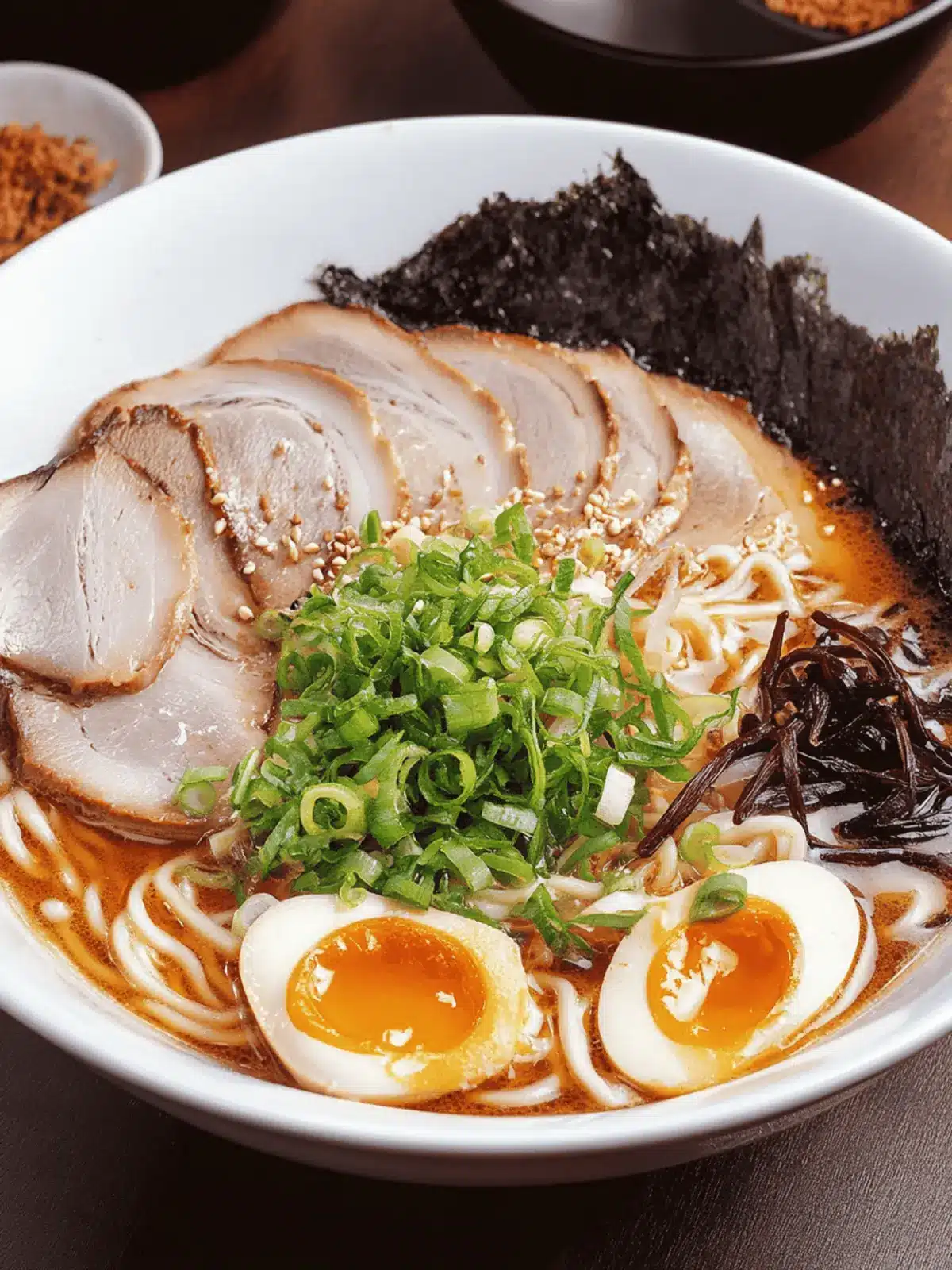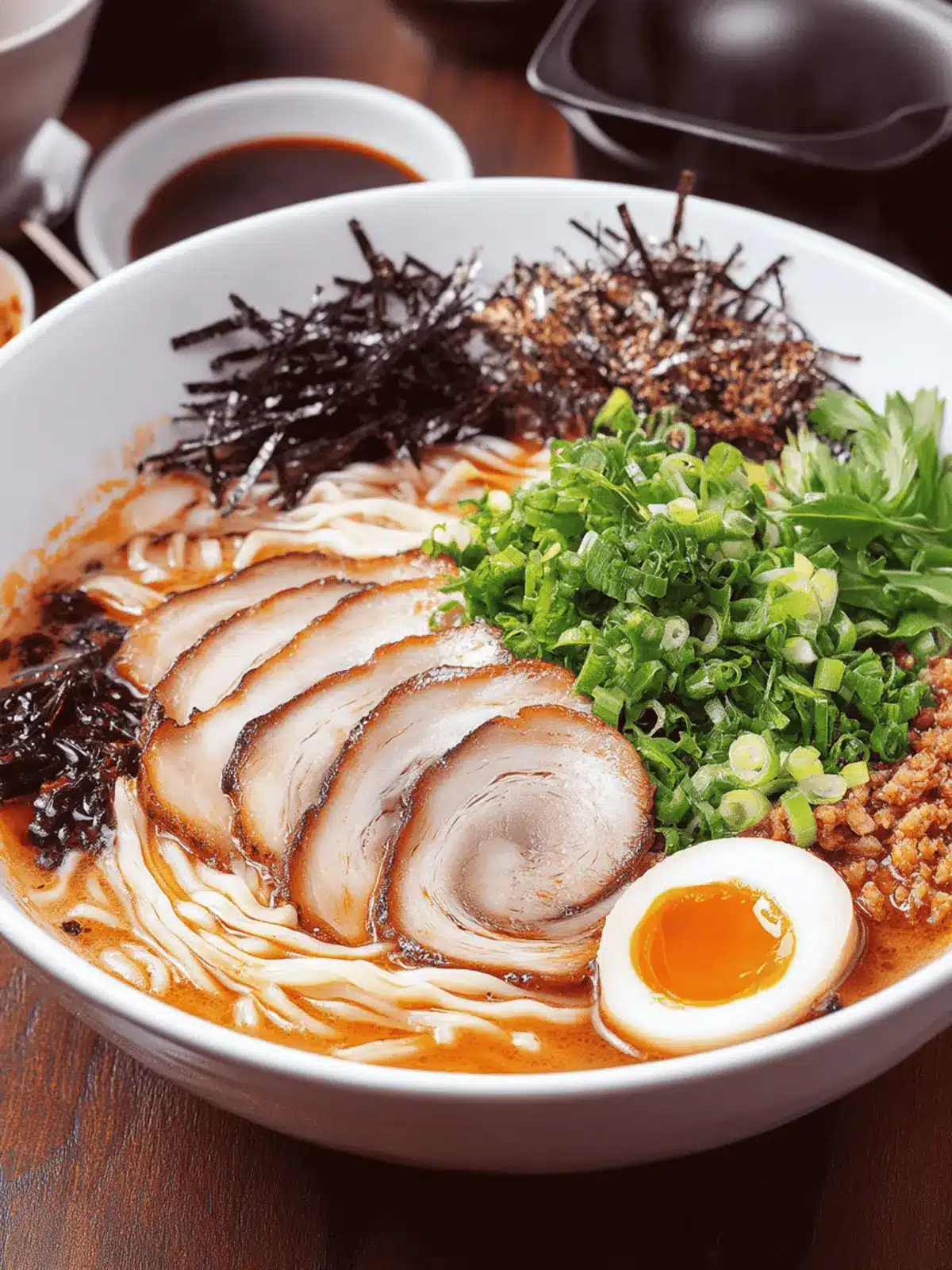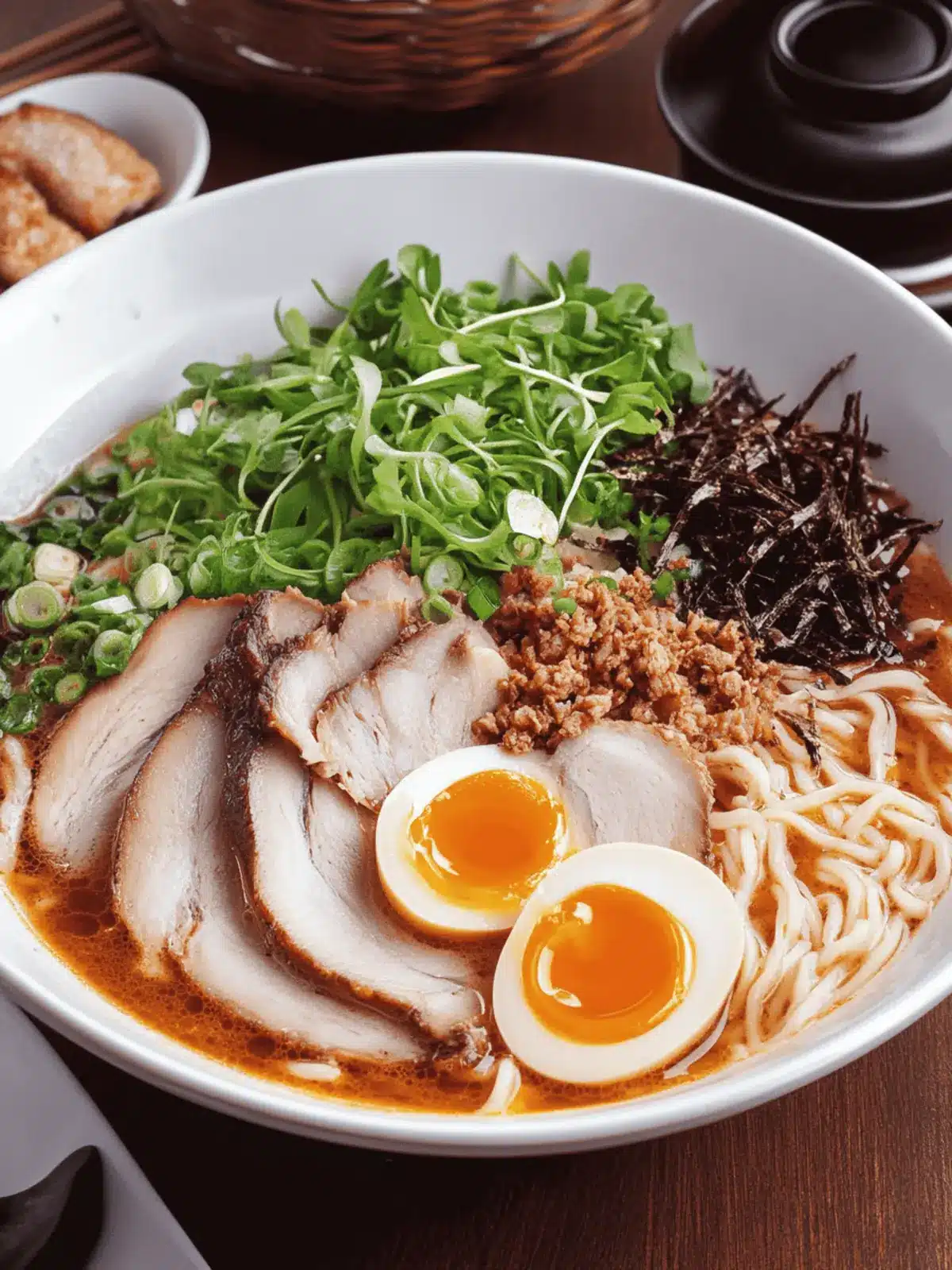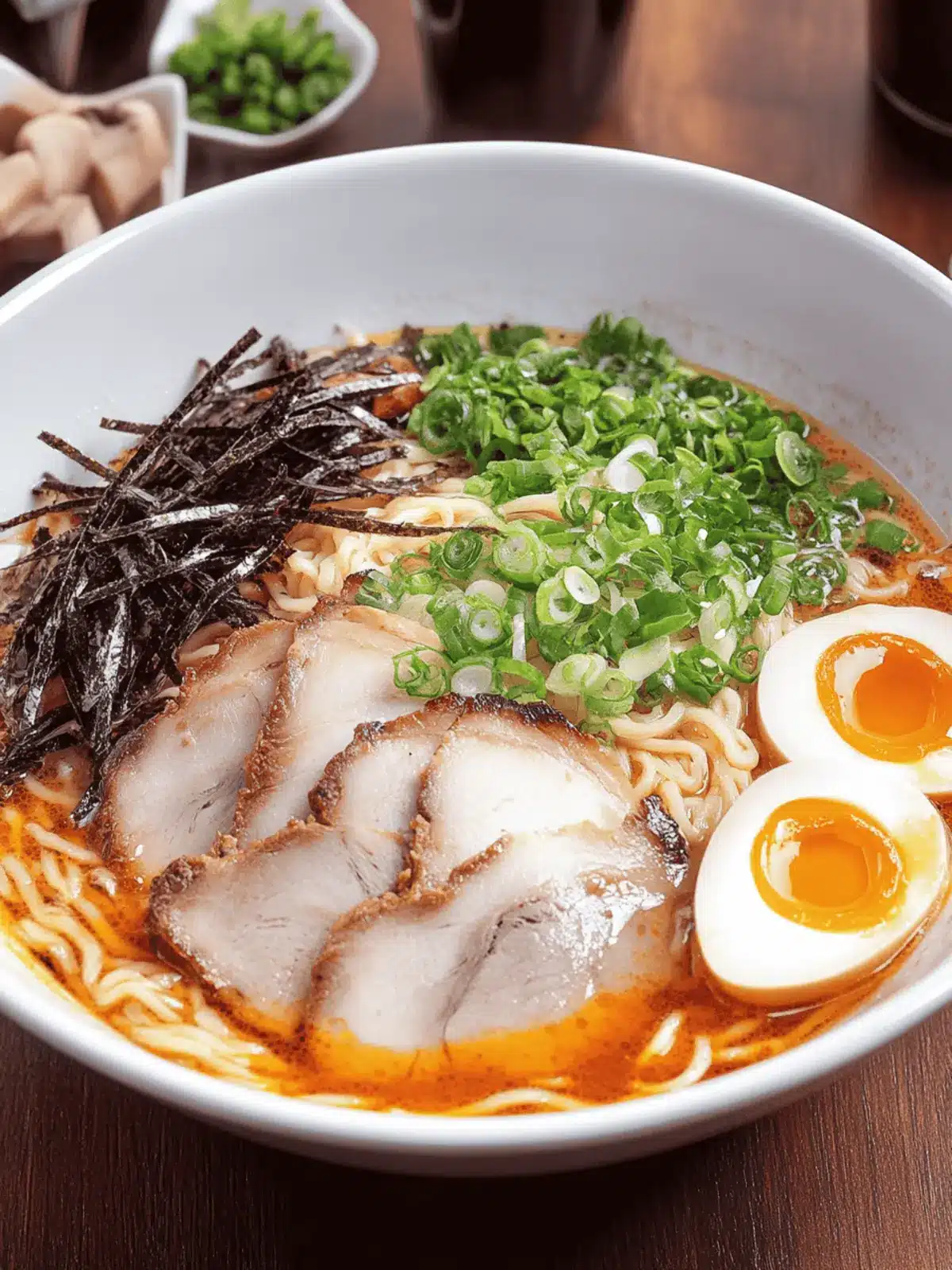When the craving for something comforting and indulgent strikes, there’s nothing quite like a steaming bowl of Japanese Tonkotsu Ramen to satisfy those hunger pangs. Imagine the rich aroma of slow-simmered pork bones wafting through your kitchen, coaxing you to take a seat and savor every mouthful. As the broth, creamy and umami-packed, dances with tender, fresh noodles, you’ll find yourself transported to a bustling ramen shop in the heart of Japan.
This recipe has transformed my weeknight dinners into a mini culinary adventure, and it’s surprisingly simple to whip up in your own home. With just a few essential ingredients, you can create a bowl of comfort that rivals even the finest ramen masters. Flavored with garlic, ginger, and a hint of mirin, this Tonkotsu Ramen strikes the perfect balance of savory and slightly sweet flavors, complemented by mouthwatering toppings like marinated soft-boiled eggs and succulent pork belly.
Join me on this journey to craft an authentic bowl of Tonkotsu Ramen that not only delights your taste buds but also brings warmth and joy to your dining table. Your family and friends will be begging for seconds!
Why is Japanese Tonkotsu Ramen So Special?
Comfort in a Bowl: There’s something undeniably warm and inviting about Japanese Tonkotsu Ramen that transforms a simple meal into a soul-soothing experience.
Decadent Umami: Slow-simmered pork bones create a rich, creamy broth, bursting with layers of umami flavor that will leave you craving more.
Easy to Customize: Feel free to swap proteins or experiment with toppings like nori or bamboo shoots, personalizing each bowl to suit your taste.
Perfect for Gatherings: Impress your family and friends with this hearty dish that is sure to please everyone at the table.
Satisfies Cravings: Indulge in this cozy bowl, ready to fulfill any comfort food cravings in your life! Prepare to elevate your weeknight dinners with this simple yet delicious recipe.
Japanese Tonkotsu Ramen Ingredients
For the Broth
• Pork Bones – Essential for creating a rich and flavorful broth; femur or knuckle bones are best for maximum collagen release.
• Onion – Provides depth of flavor; halved to infuse more effectively into the broth.
• Garlic – Enhances the aroma and adds a slight sweetness; halved crosswise for better flavor release.
• Ginger – Offers a warm, spicy note; sliced for even distribution in the broth.
• Water – The base for your broth, ensuring all flavors meld beautifully as they simmer.
For the Seasoning
• Soy Sauce – Introduces saltiness and depth; adjust to taste for perfect balance.
• Sake & Mirin – Contributes sweetness and enhances the savory elements; essential for that authentic flavor of Japanese Tonkotsu Ramen.
• Miso Paste (optional) – Adds additional umami richness; can be adjusted or omitted based on preference.
For the Noodles
• Fresh Ramen Noodles – Thin and firm, they provide the perfect texture to hold the rich broth; cook until slightly firm.
For the Toppings
• Pork Belly/Pork Shoulder – Adds tender, melt-in-your-mouth richness to your ramen bowl.
• Soft-Boiled Eggs – A must-have topping for that creamy texture; marinated for flavor enhancement.
• Green Onions – Adds freshness; chop with whites and greens separated for a beautiful presentation.
• Optional Toppings – Sliced nori, bamboo shoots, sesame seeds, and chili oil for added complexity.
How to Make Japanese Tonkotsu Ramen
-
Prepare the Broth: In a large pot, combine pork bones, onion, garlic, ginger, and enough water to cover. Bring to a boil, then reduce to a low simmer for 8 hours, skimming any impurities off the surface until the broth is opaque and creamy.
-
Season the Broth: After simmering, stir in soy sauce, sake, and mirin. If you choose to use miso paste, add it now too. Let it simmer for an additional 30 minutes to meld all the flavors beautifully.
-
Cook the Noodles: In a separate pot, cook the fresh ramen noodles according to the package instructions until slightly firm, allowing them to maintain a perfect texture. Drain and set aside.
-
Prepare Toppings: While the broth is simmering, slice the pork belly into thin pieces, peel the marinated soft-boiled eggs, and chop the green onions, making sure to keep the white and green parts separate for garnish.
-
Assemble the Ramen: When ready to serve, place a generous portion of noodles in each bowl. Ladle the hot, rich broth over the noodles, then delicately arrange the sliced pork belly, soft-boiled egg, chopped green onions, and any additional toppings you desire.
Optional: Drizzle with chili oil for a delightful kick!
Exact quantities are listed in the recipe card below.
How to Store and Freeze Japanese Tonkotsu Ramen
Fridge: Store the broth in an airtight container for up to 1 week. Keep the noodles and toppings separate to maintain their texture and freshness.
Freezer: Freeze the broth in portions using freezer-safe bags or containers for up to 3 months. When ready to use, thaw overnight in the fridge for best results.
Reheating Broth: Reheat the broth thoroughly on the stove over medium heat until it reaches a rolling boil before serving.
Noodle Storage: Fresh ramen noodles are best used immediately, but if necessary, keep any cooked noodles in the fridge for up to 2 days; reheat briefly in hot water before serving with the broth.
Expert Tips for Japanese Tonkotsu Ramen
• Simmer Longer: Extending the simmering time to 12 hours can intensify the rich flavor of your broth, maximizing its umami essence.
• Strain Well: Use a fine mesh strainer to eliminate any solid bits in the broth, ensuring a silky-smooth texture that allows the flavors to shine.
• Watch the Noodles: Avoid overcooking the ramen noodles; they should be slightly firm when drained to perfectly absorb the creamy broth without becoming mushy.
• Chill Eggs Immediately: After boiling, plunge your soft-boiled eggs into ice water to halt cooking and make peeling easier, ensuring that smooth texture with every bite.
• Customize Toppings: Get creative with your toppings! Adding items like pickled vegetables or different types of seaweed can enhance the flavor profile of your Japanese Tonkotsu Ramen.
Japanese Tonkotsu Ramen Variations
Get ready to explore exciting twists and turns on the classic Tonkotsu Ramen recipe that will delight your senses.
-
Chicken Thighs: Swap pork belly for tender chicken thighs for a lighter, leaner option without sacrificing flavor.
-
Vegetarian Delight: Use a rich mushroom broth and add tofu for a satisfying vegetarian twist that still delivers on umami.
-
Spicy Kick: Incorporate a splash of chili oil or sliced fresh chilies to the broth for a fiery flavor that warms you up!
-
Herb Infusion: Add fresh herbs like cilantro or basil to your toppings for an aromatic finish that brightens each bite.
-
Noodle Alternatives: Experiment with different types of noodles, like udon or soba, for a delightful change in texture.
-
Broth Boost: Stir in extra miso paste or a splash of fish sauce for an umami-packed broth that takes it to another level.
-
Pickled Toppings: Try adding pickled ginger or radishes for a tangy contrast that balances the richness of the broth beautifully.
-
Savory Additions: Enhance your bowl with crispy garlic chips or roasted corn, adding both texture and depth to every mouthful.
Embrace the adventure of creating your unique bowl of Tonkotsu Ramen, and let each variation inspire your culinary creativity!
Make Ahead Options
Preparing Japanese Tonkotsu Ramen in advance is a wonderful way to save time on busy weeknights! You can make the rich pork bone broth up to 3 days ahead; simply store it in an airtight container in the fridge. Similarly, the sliced pork belly and marinated soft-boiled eggs can be prepped up to 24 hours in advance, allowing flavors to meld beautifully. To ensure the noodles remain perfect, cook them just before serving, as they tend to soften over time. When you’re ready to enjoy, reheat the broth gently on the stove, and then assemble your ramen with freshly cooked noodles and toppings for a delicious meal that feels freshly made every time!
What to Serve with Japanese Tonkotsu Ramen?
Pairing perfectly with the brisk aroma of slow-cooked ramen, these complementing dishes can elevate your meal to a whole new level.
-
Gyoza: These pan-fried dumplings bring a delightful crunch and savory filling, harmonizing beautifully with the creamy broth.
-
Japanese Pickles: A refreshing side of pickled vegetables adds a satisfying crunch and acidity that cuts through the richness of the ramen.
-
Chili Oil: A drizzle of spicy chili oil can enhance the umami flavors and add a kick to your bowl of ramen, awakening your taste buds.
-
Nori Sheets: These toasted seaweed sheets provide a subtle brininess that pairs well with the savory broth, perfect for adding texture.
-
Sesame Spinach Salad: The nutty flavor of sesame dressing on fresh spinach adds a light, crisp element to your meal, balancing the heartiness of the ramen.
-
Miso Soup: For a warm, comforting appetizer, miso soup introduces a delightful umami essence, prepping your palate for the main event.
-
Japanese Beer or Sake: A refreshing Japanese lager or smooth sake pairs wonderfully with ramen, enhancing your dining experience with every sip.
-
Sweet Mochi for Dessert: Finish your meal with soft, chewy mochi filled with sweet red bean or ice cream; it’s the perfect sweet ending to your flavorful journey.
Japanese Tonkotsu Ramen Recipe FAQs
What type of pork bones should I use for the broth?
For the richest flavor in your Japanese Tonkotsu Ramen, I recommend using femur or knuckle bones. These cuts are packed with collagen, which breaks down during simmering to create that desirable creamy texture in your broth. You’ll want to select bones that have a good amount of marrow for an exceptionally flavorful broth!
How should I store leftovers of Japanese Tonkotsu Ramen?
Store the broth in an airtight container in the fridge for up to 1 week. It’s best to keep the noodles and any toppings like pork belly or eggs separate until you’re ready to enjoy your ramen again. This keeps everything fresh and maintains the perfect texture!
Can I freeze the broth?
Absolutely! You can freeze the broth for up to 3 months. Just pour it into freezer-safe bags or containers for easy portioning. When you’re ready to use it, simply thaw overnight in the fridge, and reheat thoroughly on the stove over medium heat until it’s boiling again.
What should I do if my broth is too oily or greasy?
If you find that your broth is too greasy for your taste, you can skim the fat off the top as it simmers. Just use a ladle or a spoon to carefully remove the excess fat. Alternatively, you can let the broth cool after cooking; the fat will solidify on the surface, making it easy to lift off. Just remember, a little fat contributes to the rich flavor we love in Tonkotsu!
Can I make a vegetarian version of Japanese Tonkotsu Ramen?
Certainly! You can create a lovely vegetarian interpretation by using a rich mushroom broth instead of pork bones. For added umami, retain the miso paste and include fresh vegetables like shiitake mushrooms and bok choy. This way, you keep that luxurious mouthfeel and complexity that Tonkotsu is known for!
Are there any dietary considerations to keep in mind for Japanese Tonkotsu Ramen?
Yes! If you’re serving Japanese Tonkotsu Ramen to guests, be sure to ask about any food allergies or dietary restrictions. Soy sauce can be high in sodium, so consider using a low-sodium version for those watching their salt intake. And, if you have vegetarian or vegan friends, a mushroom-based broth and omit the animal products altogether will ensure everyone can enjoy this delicious dish.

Delicious Japanese Tonkotsu Ramen: A Cozy Bowl of Umami
Ingredients
Equipment
Method
- Prepare the Broth: In a large pot, combine pork bones, onion, garlic, ginger, and enough water to cover. Bring to a boil, then reduce to a low simmer for 8 hours, skimming any impurities off the surface until the broth is opaque and creamy.
- Season the Broth: After simmering, stir in soy sauce, sake, and mirin. If you choose to use miso paste, add it now too. Let it simmer for an additional 30 minutes to meld all the flavors beautifully.
- Cook the Noodles: In a separate pot, cook the fresh ramen noodles according to the package instructions until slightly firm, allowing them to maintain a perfect texture. Drain and set aside.
- Prepare Toppings: While the broth is simmering, slice the pork belly into thin pieces, peel the marinated soft-boiled eggs, and chop the green onions, making sure to keep the white and green parts separate for garnish.
- Assemble the Ramen: When ready to serve, place a generous portion of noodles in each bowl. Ladle the hot, rich broth over the noodles, then delicately arrange the sliced pork belly, soft-boiled egg, chopped green onions, and any additional toppings you desire.








